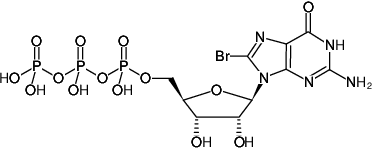(8Br-GTP)
8-Bromo-guanosine-5'-triphosphate, Sodium salt
| Cat. No. | Amount | Price (EUR) | Buy / Note |
|---|---|---|---|
| NU-118S | 50 μl (10 mM) | 157,60 | Add to Basket/Quote Add to Notepad |
| NU-118L | 5 x 50 μl (10 mM) | 461,70 | Add to Basket/Quote Add to Notepad |

For general laboratory use.
Shipping: shipped on gel packs
Storage Conditions: store at -20 °C
Short term exposure (up to 1 week cumulative) to ambient temperature possible.
Shelf Life: 12 months after date of delivery
Molecular Formula: C10H15N5O14P3Br (free acid)
Molecular Weight: 602.08 g/mol (free acid)
Exact Mass: 600.90 g/mol (free acid)
CAS#: 23197-98-0
Purity: ≥ 95 % (HPLC)
Form: solution in water
Color: colorless to slightly yellow
Concentration: 10 mM - 11 mM
pH: 7.5 ±0.5
Spectroscopic Properties: λmax 259 nm, ε 14.0 L mmol-1 cm-1 (Tris-HCl pH 7.5)
Applications:
Inhibition of RNA triphosphatases[1]
Inhibition of GTP-hydrolases[2]
Conformational studies on syn-anti dynamics of GTP[3]
Specific Ligands:
Yeast RNA triphosphates[1]
Cytoskeletal protein FtsZ and tubulin[2, 4]
BIOZ Product Citations:
Selected References:
[1] Issur et al. (2009) Nucleotide analogs and molecular modeling studies reveal key interactions involved in substrate recognition by the yeast RNA triphosphatase. Nucleic Acid Res. 37:3714.
[2] Läppchen et al. (2005) GTP Analogue Inhibits Polymerization and GTPase Activity of the Bacterial Protein FtsZ without Affecting Its Eukaryotic Homologue Tubulin. Biochemistry 44 (21):7879.
[3] Hritz and Oostenbrink (2008) Hamiltonian replica exchange molecular dynamics using soft-core interactions. J. Chemical Phys. 128:144121/1.
[4] Laeppchen et al. (2008) Probing FtsZ and tubulin with C8-substituted GTP analogs reveals differences in their nucleotide binding sites. Chemistry and Biology 15:189.
Gilles Labesse et al. (2011) Structural and functional characterization of the Mycobacterium tuberculosis uridine monophosphate kinase: insights into the allosteric regulation. Nucleic Acids Res. 39 (8):3458.